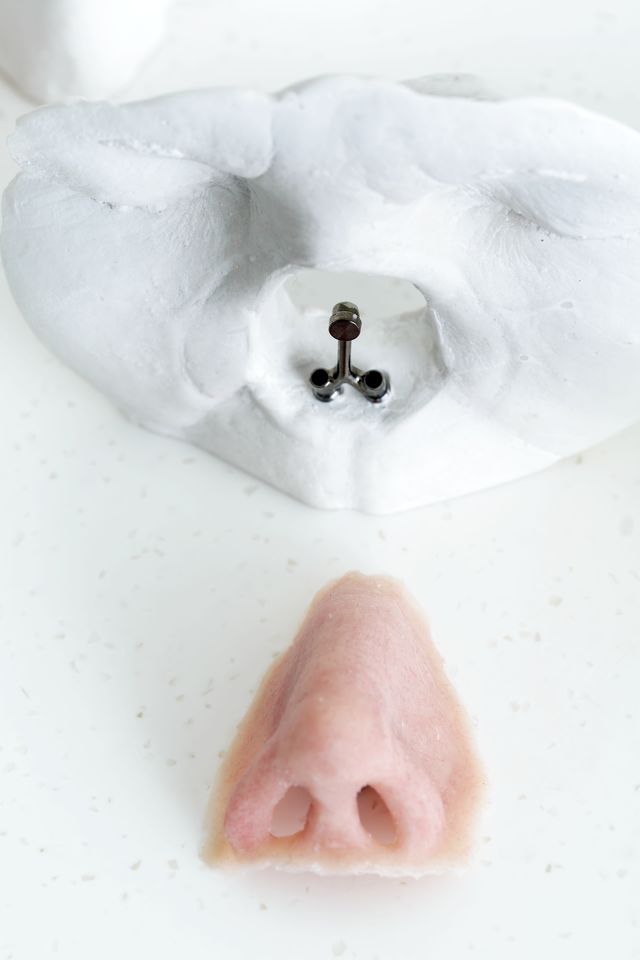Your nose or your life? The choice may seem simple, but the loss of a nose has a major impact on your life. Fortunately, after a nasal amputation you can turn to someone like Joan Saridin. She makes ears, eyes and noses from silicone for people who are missing those body parts due to an accident or illness.
Saridin is not a plastic surgeon, she emphasizes. She is an anaplastologist at Erasmus MC in Rotterdam. The patient must put on and take down the replacement body parts that Saridin makes, so-called epitheses, every day.
Replace missing part: click or paste
Saridin always makes an appointment with patients whose nose had to be removed due to a tumor before the operation is performed. ‘It is difficult to estimate in advance how much needs to be removed, so we discuss all options.’ Sometimes the surgeon only removes a small piece. ‘Then I make a partial epithesis that replaces the missing part.’
Sometimes the entire nose has to be removed, but the bone underneath is unaffected and the surgeon can place implants. The doctor then places metal sleeves in the bone. After a few months they have grown together and screws are screwed in. Saridin places magnets in the silicone nose. In the morning the patient clicks his nose into place using those magnets, and in the evening he takes it off again.
Implants and magnets are often not an option if the tumor has affected the bone. When the wound has healed, Saridin makes a glue epithesis in such a case. The patient sticks the new nose to the skin himself with medicinal glue. ‘I want people to be able to walk on the street without being looked at.’
It takes some getting used to
It takes some getting used to for her patients, says Saridin. They have to get used to the idea of having to continue without a nose, then they have to get used to the plaster where there used to be a nose. ‘They find it especially difficult to see their faces from the side. Without a nose it’s so flat.’ The red cavity under the patch is also scary.
‘And when they finally get used to that patch, they get their nose stuffed again. It’s a different sight again.’ Yet most patients cannot wait until they receive their epithesis.
Colors must match
How does Saridin make a new nose? Sometimes she can make an impression of the patient’s nose before it goes under the knife. This gives her an example for the epithesis. It is also possible that a CT scan has been made of the patient’s head in the hospital. Based on such a scan, she can make a replica of the nose with a 3D printer.
Based on the print or impression, the anaplastologist ‘models’ a first model of the new nose, made of pink wax. It also happens that there is no print or print available. Saridin then models a pink nose based on photos. For example, by drawing some lines in the wax model, she recreates grooves that naturally occur on an older nose. With a few taps with a wire brush she recreates the dimples in the skin. Just look in the mirror: your skin is not smooth.
Modeling together with the patient
The patient must come by for the next step. ‘I do the modeling together with the patient, because they have to walk around with it.’ Aren’t the nostrils too big? Wasn’t the actual nose a millimeter narrower?
The most important thing is symmetry. “My nose is a bit asymmetrical,” Saridin gives as an example. ‘That’s okay, because it’s natural. But with an epithesis it is immediately noticeable if it is asymmetrical. People expect something that is fake to be perfect.”
The nose wash must also fit snugly to the skin. That’s why it’s important to have a laugh. The facial expression sometimes creates a small crack on the side of the epithesis. And if someone wants something different, a size smaller for example? That is possible, says Saridin. It also happens that patients who had a lump on their nose prefer to have a nose without a lump. ‘They want a nice nose now. And that’s allowed.’
Silicone nose from the oven
The anaplastologist makes a plaster mold from the wax model. The silicone solution that she will pour in there must get the right color. Saridin used to mix colors by eye, but nowadays a device measures a person’s skin color.
If it concerns a new nose, she determines the color on the forehead and cheeks. These are the places where the color of the epithesis must blend seamlessly with that of the skin. Based on the measurement, she mixes dyes into the liquid silicone until she gets the right shades.
She also adds some fine brown flecks, for example. These form small spots, because many patients have somewhat spotty skin. She could even make little veins out of red yarn she took apart. ‘But usually people don’t need to get the veins on their nose back.’ After 45 minutes of hardening in the oven, a new nose emerges from the mold.
Six-monthly nose check
The patient then comes for a check-up every six months. Is the color still good? Is the nose still comfortable? The silicone nose slowly becomes harder. This is especially uncomfortable if you have to laugh or sneeze.
On average, once every two years, Saridin presses a new nose for her patients. It will then be a lot more comfortable. The new color also fits the face better. “Silicone discolours slowly,” says Saridin.
Before someone can leave with a new nose, Saridin adds color to the epithesis. A precise job. ‘Sometimes I think the shade is just right. Then the patient turns his head to the window so that daylight falls on it, and it looks different than I thought.’ Saridin’s rule of thumb is that the epithesis should look good in natural light.
Not to blow your nose
Technology has advanced enormously. For example, magnets used to not be as strong as they are now. Saridin: ‘A nose could just come loose if you touched someone’s cheek while kissing.’
The noses have also been improved on the inside. A patient’s nasal cavity often still functions properly, for example he can smell and taste just fine. But it also means that the mucous membranes, like all working mucous membranes, produce moisture. Unfortunately, blowing an epithesis is not possible. It is therefore important to clean the nasal cavity with a cotton ball a few times a day.
A solution has also been devised for a cold or a runny nose: a cup can be made on the inside of the nose, above the nostrils. It is a matter of emptying it in time and rinsing it under the tap.
Old nose goes home again
And what to do with old noses? These prove to be very useful to have on hand. For example, a Saridin patient uses his old nose as a shower nose, otherwise the water splashes in his nasal cavity.
A smoking patient uses his former nose as a smoking nose, because tobacco smoke turns the silicone yellow. ‘Yet another patient turned his old nose up at barbecuing and frying fries. Because that smell lingers in it.’ For example, an artificial nose can be unexpectedly useful.
This article previously appeared in Quest 07/2017











